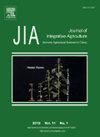Pharmacokinetics of Quinocetone and Its Major Metabolites in Swine After Intravenous and Oral Administration
Abstract
The pharmacokinetics of quinocetone and its major metabolites in healthy swine was investigated in this paper. Quinocetone was administered to 8 healthy cross-bread swine intravenously and orally at a dosage of 4 and 40 mg kg−1 body weight respectively in a randomized crossover design test with two-week washout period. A sensitive high-performance liquid chromatography-tandem mass spectrometry (HPLC-MS/MS) method was developed for the determination of quinocetone and its metabolite 1-desoxyquinocetone in plasma. Plasma concentration versus time profiles of quinocetone and its metabolite 1-desoxy quinocetone were analyzed by non-compartmental analysis using Winnonlin 5.2 software. Mean maximum concentrations (Cmax) for quinocetone was found to be (0.56±0.13) μg mL−1 at 2.92 h, after oral administration of quinocetone. Mean maximum concentrations (Cmax) for 1-desoxy quinocetone after intravenous or oral administration of quinocetone were (0.0095±0.0012) μg mL·1 at 0.083 h and (0.0067±0.0053) μg mL−1 at 3.08 h. The apparent elimination half-lives (T1/2) for quinocetone and its metabolite 1-desoxy quinocetone were (2.24±0.24) and (5.23±0.56) h after intravenous administration of quinocetone and (2.91±0.29) and (11.85±2.89) h after oral administration of quinocetone, respectively. Mean areas under the plasma concentration-time curve (AUC0-x) for quinocetone and 1-desoxyquinocetone were (2.02±0.15) and (0.2±0.002) μg h mL−1 respectively after intravenous administration of quinocetone, and (3.5±0.79) and (0.053±0.03) μg h mL−1 after oral administration of quinocetone, respectively. Quinocetone was rapidly absorbed and metabolized in swine after oral and intravenous administration. The plasma concentration-time curve (AUC0-x) of 1-desoxy quinocetone were much smaller than those of quinocetone, while the elimination half-lives (T1/2) were much longer than those of quinocetone after intravenously (i.v.) or oral administration.

 求助内容:
求助内容: 应助结果提醒方式:
应助结果提醒方式:


